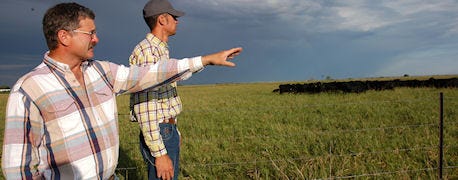July 1, 2012

Jim and Lee Kopriva say they have some good reasons for converting cropland to grass.
The farther and son raise Angus cattle together in eastern South Dakota near Raymond, S.D. With high corn and bean prices lately, most of land conversions around them has been going the other way – from grass or CRP to cropland.
But they are first and foremost beef producers. It's their passion. Also, the soil on their farm is light and sandy. The farm located on the western edge of the Coteau Hills. The soils produce good crops when the weather is wet, but watch out when it gets dry. Corn and beans can lose yield potential rapidly, they say.

Jim (left) and Lee, are going in a different different direction, coverting cropland to grassland in eastern South Dakota
Reestablishment of grasses, especially native grasses, increases organic matter and water infiltration, allowing the soil to absorb and hold more water.
Also, grass is more financially sustainable for them. They don't have a big line of row crop equipment and ever increasing fertilizer and pesticide inputs to deal with.
With rotational grazing they have been able to more than double stocking rates without hurting the resource. Their graze-and-rest strategy actually improves grass and soil health.
"It's a win-win," Jim says.
For more details, see the July issue of Dakota Farmer. For a copy, email [email protected]
You May Also Like




